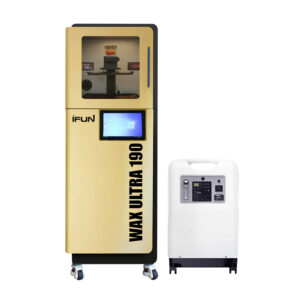
Factors Affecting UV Resin 3D Printer Speed
- The Role of UV Light Source in Printing Speed
- DLP resin printers expose entire layers at once, making them significantly faster than traditional SLA UV printers, which use a laser to trace the shape.
- Increasing power density improves UV printing speed. For example, at 16 J/cm², a layer might take 2 minutes to cure, but at 20 J/cm², the same layer can cure in less than one minute.
- Optimizing the printer UV wavelength enhances resin polymerization, reducing exposure time and improving efficiency.
- The WAX ULTRA 190 UV printer, equipped with an oxygen-permeable release film, optimizes the curing process, ensuring faster printing speeds and higher-quality surfaces.

- Resin Formulation: Does It Affect Speed?
- Fast-curing UV resins harden in seconds, while specialized formulations (such as flexible or high-temperature resins) require longer exposure.
- Resins with optimized photoinitiators react more efficiently to UV printing light, reducing layer cure time.
- Viscosity impacts speed: Lower-viscosity 3D printer resin spreads faster, shortening layer preparation time between prints.
- IF900D White Wax Resin, designed specifically for jewelry casting, is an example of a high-wax-content resin that prints efficiently. It offers low shrinkage, smooth surface finishes, and excellent casting properties, making it ideal for high-detail jewelry production.

- Printing Technologies That Boost Speed
- CLIP (Continuous Liquid Interface Production) Technology: This eliminates the layer-by-layer curing process, increasing speed by 20-100x compared to standard UV printing machines.
- LSVP (Linear Scanning UV Printing) Technology: This method uses a synchronized scanning mechanism that improves throughput while maintaining high precision.
- Oxygen-controlled curing: Controlled oxygen layers can regulate polymerization, increasing speed while maintaining print quality.
- WAX ULTRA 190 DLP Printer, an industrial-grade jewelry 3D printer, integrates an oxygen-permeable release film, optimizing the printing process for high-wax-content resins like IF900D. This feature enables faster, continuous printing while ensuring smooth surface quality.
- Layer Thickness and Print Speed Trade-offs
How Fast Can UV Resin 3D Printers Really Print?
Speed Ranges by Technology
Technology | Print Speed (mm/hour) | Curing Speed per Layer |
SLA (Laser-based) | 10-30 mm/h | 5-15 seconds |
DLP (Projector-based) | 50-80 mm/h | 2-5 seconds |
CLIP (Continuous) | 100-500 mm/h | Near-instantaneous |
LSVP (Linear Scanning) | 80-150 mm/h | 1-4 seconds |
Real-World Performance
- Jewelry prototyping: A best resin 3D printer for jewelry can complete a ring model in 15-30 minutes with high precision. The WAX ULTRA 190, with its high-resolution DLP light engine and large build size, allows for printing up to 104 rings in just 1.5 hours, making it a top choice for mass jewelry production.
- Dental applications: DLP resin printers can print a full tray of dental aligners in 30-60 minutes.
- Industrial parts: Large-format UV printing machines achieve speeds of 100 mm/hour, reducing production time significantly.
How to Improve UV Resin 3D Printing Speed
- Use a high-intensity light source: More powerful UV LEDs or lasers accelerate curing.
- Optimize resin selection: Choose fast-curing 3D printing UV resins like IFUN’s White Wax Resin 900D, which is optimized for fast, detailed jewelry casting.
- Adjust layer thickness: Find the balance between speed and resolution.
- Implement advanced curing techniques: CLIP and LSVP improve efficiency.
- Optimize print orientation: Reducing supports and repositioning models minimizes print time.
Frequently Asked Questions (FAQ)
Q1: How long does it take for a DLP UV resin 3D printer to print?
A: It depends on the technology. SLA printers may take a few hours, while CLIP-based UV printers can print models in minutes.
Q2: Which UV resin 3D printer has the fastest speed?
A: CLIP-based printers like those from Carbon3D offer the fastest speeds, reaching up to 500 mm/hour.
Q3: What factors affect UV printing speed?
A: Key factors include light source intensity, resin formulation, layer thickness, and printing technology.
Q4: How long to cure resin prints in a UV printer?
A: Curing times vary based on the resin type and light intensity. Standard UV curing can take a few minutes to an hour depending on exposure conditions.

